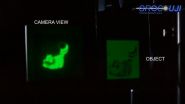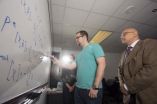(Press-News.org) VIDEO:
After the diffuser, the information content of the object is scrambled so that the light distribution at the pixelated sensor looks like the familiar speckle noise.
Click here for more information.
Optical imaging methods are rapidly becoming essential tools in biomedical science because they're noninvasive, fast, cost-efficient and pose no health risks since they don't use ionizing radiation. These methods could become even more valuable if researchers could find a way for optical light to penetrate all the way through the body's tissues. With today's technology, even passing through a fraction of an inch of skin is enough to scatter the light and scramble the image.
Now a team of researchers from Spain's Jaume I University (UJI) and the University of València has developed a single-pixel optical system based on compressive sensing that can overcome the fundamental limitations imposed by this scattering. The work was published today in The Optical Society's (OSA) open-access journal Optics Express.
"In the diagnostic realm within the past few years, we've witnessed the way optical imaging has helped clinicians detect and evaluate suspicious lesions," said Jesús Lancis, the paper's co-author and a researcher in the Photonics Research Group at UJI. "The elephant in the room, however, is the question of the short penetration depth of light within tissue compared to ultrasound or x-ray technologies. Current knowledge is insufficient for early detection of small lesions located deeper than a millimeter beneath the surface of the mucosa."
"Our goal is to see deeper inside tissue," he added.
To achieve this, the team used an off-the-shelf digital micromirror array from a commercial video projector to create a set of microstructured light patterns that are sequentially superimposed onto a sample. They then measure the transmitted energy with a photodetector that can sense the presence or absence of light, but has no spatial resolution. Then they apply a signal processing technique called compressive sensing, which is used to compress large data files as they are measured. This allows them to reconstruct the image.
One of the most surprising aspects of the team's work is that they use essentially a single-pixel sensor to capture the images. While most people think that more pixels result in better image quality, there are some cases where this isn't true, Lancis said. In low-light imaging, for instance, it's better to integrate all available light into a single sensor. If the light is split into millions of pixels, each sensor receives a tiny fraction of light, creating noise and destroying the image.
"Something similar happens when you try to transmit images through scattering media," Lancis said. "When we use a conventional digital camera to get an image, we only see the familiar noisy pattern known as 'speckle.' In compressive imaging, since we aren't using pixelated sensors, it should be less sensitive to light scrambling and enable transmission of images through scattering."
Also notable, the team's technique could operate through dynamic scattering. "Most scattering media of interest, like biological tissue, are dynamic in the sense that the scatter centers continuously change their positions with time -- meaning that the speckle patterns are 'in motion.' This is ideal for some applications because monitoring the changes of the speckle can reveal information about the sample, but the drawback is that it's a major nuisance to transmit or get images," Lancis pointed out. "Our technique, however, requires no calibration of the medium, and its fluctuations during the sensing stage don't limit imaging ability."
What's ahead for the team? "Our next goal is to break the barriers of light penetration depth inside a scattering medium with the state-of-the-art megapixel-programmable spatial light modulators used in consumer electronics," Lancis says. To do this, they'll need to demonstrate that their technique works even when the sample is embedded inside the tissue.
INFORMATION:
Paper: "Image transmission through dynamic scattering media by single-pixel photodetection," E. Tajahuerce et al., Optics Express, Vol. 22, Issue 14, pp. 16945-16955 (2014). http://www.opticsinfobase.org/oe/abstract.cfm?uri=oe-22-14-16945
EDITOR'S NOTE: Images and video are available to members of the media upon request. Contact Angela Stark, astark@osa.org.
About Optics Express
Optics Express reports on new developments in all fields of optical science and technology every two weeks. The journal provides rapid publication of original, peer-reviewed papers. It is published by The Optical Society and edited by Andrew M. Weiner of Purdue University. Optics Express is an open-access journal and is available at no cost to readers online at http://www.OpticsInfoBase.org/OE.
About OSA
Founded in 1916, The Optical Society (OSA) is the leading professional society for scientists, engineers, students and business leaders who fuel discoveries, shape real-world applications and accelerate achievements in the science of light. Through world-renowned publications, meetings and membership programs, OSA provides quality research, inspired interactions and dedicated resources for its extensive global network of professionals in optics and photonics. For more information, visit http://www.osa.org.
Overcoming light scattering: New optical system sees deeper inside tissue
Technique uses commercial video projector, single pixel sensor and compressive sensing to penetrate through scattering media
2014-07-02
ELSE PRESS RELEASES FROM THIS DATE:
Becoming an expert takes more than practice
2014-07-02
Deliberate practice may not have nearly as much influence in building expertise as we thought, according to research published in Psychological Science, a journal of the Association for Psychological Science.
Scientists have been studying and debating whether experts are "born" or "made" since the mid-1800s. In recent years, deliberate practice has received considerable attention in these debates, while innate ability has been pushed to the side, due in part to the famous "10,000-hour rule" coined by Malcolm Gladwell in his 2008 book Outliers.
The new study, from psychological ...
Joslin scientists identify process that affects fat distribution and metabolic syndrome
2014-07-02
BOSTON – July 1, 2014 – Building upon their earlier research on the biology of fat metabolism, Joslin scientists discovered that microRNAs –small RNA molecules that play important roles in regulation in many types of tissue – play a major role in the distribution and determination of fat cells and whole body metabolism. Also, the study is the first to reveal that microRNAs (miRNAs) influence the development of lipodystrophy (abnormal fat accumulation) which affects many people with HIV receiving anti-retroviral therapy. The findings appear in the August issue of the Journal ...
UH researchers identify one of world's thinnest piezoelectric materials
2014-07-02
HOUSTON, July 1, 2014 – There are a handful of naturally occurring materials, known as piezoelectric materials, that generate electricity if you bend, stretch or apply another mechanical force to them, and vice versa – if you apply a voltage across them, they'll deform accordingly. These materials are currently the subject of intense research for their potential applications in energy harvesting, artificial muscles and sensors, among others. These materials are also used in everyday devices, such as loudspeakers, which rely on piezoelectrics to convert electrical signals ...
3D printer to aid the visually impaired students in their educational endeavors
2014-07-02
Braille is a tactile writing system, which is commonly used by the visually impaired and partially sighted. With the recent development of braille printers, written materials in braille has greatly helped the visually impaired and partially sighted individuals but, this is not to say that there are still many remaining problems such as books that are immobile due to their size and volume as well as durability. Moreover, there are other problems such as not enough books, materials, works, and data for such individuals.
New technology has been developed to make tactile ...
Comedy, the refuge of gays in Franco-era cinema
2014-07-02
This news release is available in Spanish.
This research studies the presence and visibility of the gay world in Spanish cinema between 1940 and 1975. The report, published in the journal Zer by Alejandro Melero, professor in the UC3M Department of Journalism and Audiovisual Communication, shows that there were genres that homosexuality appeared in more frequently. One such genre is comedy, in which it was very usual to portray gays as funny characters.
Beyond our borders—and in sharp contrast to Spanish cinema—directors like Alfred Hitchcock were forerunners in ...
Research could lead to dramatic energy savings at data farms
2014-07-02
PULLMAN, Wash. - Washington State University has developed a wireless network on a computer chip that could reduce energy consumption at huge data farms by as much as 20 percent.
Researchers led by Partha Pande, a computer engineering professor in the School of Electrical Engineering and Computer Science, have filed two patents on their wireless multicore chip design, which could also speed up data processing. The team, which includes associate professors Deukhyoun Heo and Benjamin Belzer, has a paper on their work in the May issue of ACM Journal on Emerging Technologies ...
Alcohol backing raises risk of athletes drinking more
2014-07-02
Alcohol sponsorship and hazardous drinking in UK athletes are linked, a new study has found.
The research, led by Monash University and the University of Manchester, is the first to examine alcohol sponsorship of athletes in the UK, and comes at a time when there are calls in Australia, New Zealand, UK, Ireland, and South Africa for greater restriction or bans on alcohol sponsorship and advertising in sport. The research was published today in the scientific journal Addiction.
The researchers surveyed more than 2000 sportspeople from universities in the North West, ...
Flood fear has temporary effect on property prices: QUT study
2014-07-02
The stigma of buying in a flood-prone suburb after the 2011 Brisbane floods was short-lived for middle and high-value homes with property prices rebounding within 12-months, a QUT study has found.
Property economics expert Professor Chris Eves, from QUT's Science and Engineering Faculty, studied the short-term impact of the 2011 flood on the Brisbane residential housing market and found flood fear had a minimal on-going effect on property prices, with low-value suburbs being the exception.
"What we found was that because people in the higher-value suburbs (St Lucia, ...
Making dreams come true: Making graphene from plastic?
2014-07-02
Graphene is gaining heated attention, dubbed a "wonder material" with great conductivity, flexibility and durability. However, graphene is hard to come by due to the fact that its manufacturing process is complicated and mass production not possible. Recently, a domestic research team developed a carbon material without artificial defects commonly found during the production process of graphene while maintaining its original characteristics. The newly developed material can be used as a substitute for graphene in solar cells and semiconductor chips. Further, the developed ...
New approach for tuberculosis drugs
2014-07-02
Consumption was one of the worst known diseases of the 18th century. Thanks to medical advances, the number of deaths from this lung disease – which is today known as tuberculosis – has declined significantly. Efforts to eradicate the disease in the 1950s and 1960s resulted in a wide range of new drugs entering the market.
And yet 1.4 million people still continue to die each year from tuberculosis. Multidrug-resistant strains of the disease-causing pathogen are especially dangerous because they can no longer be treated with today's drugs (see box). "In the past 50 years, ...
LAST 30 PRESS RELEASES:
iPS cells from dish to freezer and back
Deep neural networks enable accurate pricing of American options under stochastic volatility
Collective risk resonance in Chinese stock sectors uncovered through higher-order network analysis
Does CPU impact systemic risk contributions of Chinese sectors? Evidence from mixed frequency methods with asymmetric tail long memory
General intelligence framework to predict virus adaptation based on a genome language model
Antibiotic resistance is ancient, ecological, and deeply connected to human activity, new review shows
Vapes, pouches, heated tobacco, shisha, cigarettes: nicotine in all forms is toxic to the heart and blood vessels
From powder to planet: University of Modena engineers forge a low-carbon future for advanced metal manufacturing
Super strain-resistant superconductors
Pre-school health programme does not improve children’s diet or physical activity, prompting call for policy changes, study finds
Autumn clock change linked to reduction in certain health conditions
AI images of doctors can exaggerate and reinforce existing stereotypes
Where medicine meets melody – how lullabies help babies and parents in intensive care
We may never be able to tell if AI becomes conscious, argues philosopher
AI video translation shows promise but humans still hold the edge
Deep ocean earthquakes drive Southern Ocean’s massive phytoplankton blooms, study finds
Without campus leftovers to pick through, the beaks of this bird changed shape during the pandemic
High-dose antibiotic does not reduce mortality in tuberculous meningitis
How many insects fly in the sky above the USA?
Could cheese protect your brain health?
Who faces more difficulty recovering from stroke?
Colliding galaxies create the brightest, fastest growing black holes at their center
New BrainHealth research reveals tradeoffs on sleep with cannabis use for chronic pain
Aging-US now on ResearchGate, enhancing visibility for authors and readers
'Molecular glue' stabilizes protein that inhibits development of non-small cell lung cancer
Mount Sinai Health System is recognized in 2025 Chime Digital Health Most Wired survey
From prey to predator: How carnivores spread beneficial fungi
Menopause symptoms may be frequent and have negative effects, according to female endurance athletes
US Congressmembers’ responses on X to mass shooting events differ along party lines
KAIST-UEL team develops “origami” airless wheel to explore lunar caves
[Press-News.org] Overcoming light scattering: New optical system sees deeper inside tissueTechnique uses commercial video projector, single pixel sensor and compressive sensing to penetrate through scattering media





